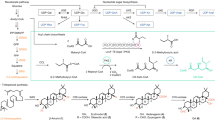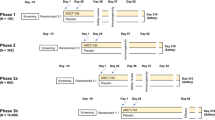Abstract
Two univalent subunit vaccines that are based on major virulence traits of Candida albicans have completed Phase I clinical trials in recent years. Although it is hoped that at least one will become the first antifungal vaccine approved for human use, there are some major obstacles to achieving this. The difficulties mostly arise from the remarkable ability of C. albicans to deceive the host immune system. In this Opinion article, I argue that the development of a multivalent vaccine that induces an immune response against multiple, unrelated virulence traits of this human commensal fungus and opportunistic pathogen may be a better approach.
This is a preview of subscription content, access via your institution
Access options
Subscribe to this journal
Receive 12 print issues and online access
$209.00 per year
only $17.42 per issue
Buy this article
- Purchase on Springer Link
- Instant access to full article PDF
Prices may be subject to local taxes which are calculated during checkout



Similar content being viewed by others
References
Cutler, J. E., Deepe, G. S. & Klein, D. Advances in combating fungal diseases: vaccines on the threshold. Nature Rev. Microbiol. 5, 13–28 (2007).
Cassone, A. Fungal vaccines: real progress from real challenge. Lancet Infect. Dis. 8, 114–124 (2008).
Cassone, A. & Casadevall, A. Recent progress in vaccines against fungal diseases. Curr. Opin. Microbiol. 15, 1–7 (2012).
Edwards, J. E. Fungal cell wall vaccines: an update. J. Med. Microbiol. 61, 895–903 (2012).
De Bernardis, F. et al. A virosomal vaccine against candidal vaginitis: immunogenicity, efficacy and safety profile in animal models. Vaccine 30, 4490–4498 (2012).
Schmidt, C. S. et al. NDV-3, a recombinant alum-adjuvanted vaccine for Candida and Staphylococcus aureus is safe and immunogenic in healthy adults. Vaccine 30, 7594–7600 (2012).
Torosantucci, A. et al. A novel glyco-conjugate vaccine against fungal pathogens. J. Exp. Med. 202, 597–606 (2005).
Bromuro, C. et al. β-glucan–CRM197 conjugates as candidates antifungal vaccines. Vaccine 28, 2615–2623 (2010).
Xin, H., Dziadek, S., Bundle, D. R. & Cutler, J. E. Synthetic glycopeptide vaccines combining β-mannan and peptide epitopes induce protection against candidiasis. Proc. Natl Acad. Sci. USA 105, 13526–13531 (2008).
Han, Y. & Rhew, K. Y. Comparison of two Candida mannan vaccines: the role of complement in protection against disseminated candidiasis. Arch. Pharm. Res. 35, 2021–2027 (2012).
Cassone, A. & Rappuoli, R. Universal vaccines: shifting to one for many. mBio 1, e00042–10 (2010).
Pfaller, M. A. & Diekema, D. J. Epidemiology of invasive mycoses in North America. Crit. Rev. Microbiol. 36, 1–53 (2010).
Cassone, A. & Cauda, R. Candida and candidiasis in HIV-infected subjects. Where commensalism, opportunistic behavior and frank pathogenicity lose their borders. AIDS 26, 1457–1472 (2012).
Foxman, B., Muraglia, R., Dietz, J., Sobel, J. D. & Wagner, J. Prevalence of recurrent vulvovaginal candidiasis in 5 European countries and the United States: results from an internal panel survey. J. Low. Genit. Tract Dis. 17, 340–345 (2013).
Pappas, P. G. Invasive candidiasis. Infect. Dis. Clin. North Am. 20, 485–506 (2006).
Diekema, D., Arbefeville, S., Boyken, L., Kroeger, J. & Pfaller, M. The changing epidemiology of healthcare-associated candidemia over three decades. Diagn. Microbiol. Infect. Dis. 73, 45–48 (2012).
Klis, F. M., de Koster, C. G. & Brul, S. A mass spectrometric view of the fungal wall proteome. Future Microbiol. 6, 941–951 (2011).
Plain, A. et al. Functional analysis of Candida albicans GPI-anchored proteins: roles in cell wall integrity and caspofungin sensitivity. Fungal Genet. Biol. 45, 1404–1414 (2008).
LeibundGut-Landman, S., Wutrich, M. & Hohl, T. Immunity to fungi. Curr. Opin. Immunol. 24, 1–10 (2012).
Romani, L. Immunity to fungal infections. Nature Rev. Immunol. 11, 275–288 (2011).
Gaffen, S. L. Hernández-Santos, N. & Peterson, A. C. IL-17 signaling in host defense against Candida albicans. Immunol. Res. 50, 181–187 (2011).
Carvalho, A. et al. Host defense pathways against fungi: the basis for vaccines and immunotherapy. Front. Microbiol. 3, 1–9 (2012).
Zelante, T. et al. IL-17/Th17 in anti-fungal immunity: what's new? Eur. J. Immunol. 39, 645–648 (2009).
Kaufmann, S. The contribution of immunology to the rational design of novel antibacterial vaccines. Nature Rev. Microbiol. 5, 491–504 (2007).
Lin, L. et al. Th1-Th17 cells mediate protective adaptive immunity against Staphylococcus aureus and Candida albicans infection in mice. PLoS Pathog. 5, e1000703 (2009).
Spellberg, B. et al. Antibody titer threshold predicts anticandidal vaccine efficacy even though the mechanism of protection is induction of cell-mediated immunity. J. Infect. Dis. 197, 957–971 (2008).
Luo, G. et al. Human anti-Als3p antibodies enhance phagocyte-mediated killing of C. albicans and S. aureus and prevent Als3 function. Abstract 178A in: 11th American Society for Microbiology Conference on Candida and Candidiasis (2012).
Almond, J. W. Vaccine renaissance. Nature Rev. Microbiol. 5, 479–482 (2007).
Kniemeyer, O. Schmidt, A. D., Vödisch, M. Wartenberg, D. & Brakhage, A. A. Identification of virulence determinants of the human pathogenic fungi Aspergillus fumigatus and Candida albicans by proteomics. Int. J. Med. Microbiol. 301, 368–377 (2011).
Mayer, F. L., Wilson, D. & Hube, B. Candida albicans pathogenicity mechanisms. Virulence 42, 1–10 (2013).
Lesiak-Markowicz, I. et al. Candida albicans Hgt1p, a multifunctional evasion molecule: complement inhibitory, CR3 analogue and human immunodeficiency virus-binding molecule. J. Infect. Dis. 204, 802–809 (2009).
Luo, S., Hoffmann, R., Sharka, C. & Zipfel, P. E. Glycerol-3-phosphate dehydrogenase 2 is a novel factor H-,factor H-like protein 1-, and plasminogen-binding surface protein of Candida albicans. J. Infect. Dis. 207, 594–603 (2013).
Frohner, I. E., Bourgeois, C., Yatsik, K., Mayer, O. & Kuchler, K. Candida albicans cell surface superoxide dismutases degrade host-derived reactive oxygen species to escape innate immunity surveillance. Mol. Microbiol. 71, 240–252 (2009).
Cheng, S. et al. Candida albicans dampens host defence by downregulating IL-17 production. J. Immunol. 185, 2450–2457 (2010).
Zelante, T. et al. Sensing of mammalian IL-17A regulates fungal adaptation and virulence. Nature Commun. 3, 683–687 (2013).
Bromuro, C. et al. Interplay between protective and inhibitory antibodies dictates the outcome of experimentally disseminated candidiasis in recipients of a Candida albicans vaccine. Infect. Immun. 70, 5462–5470 (2002).
Cutler, J. E., Corti, M., Lambert, P., Ferris, M. & Xin, H. Horizontal transmission of Candida albicans and evidence for a vaccine response in mice colonized with the fungus. PLoS ONE 6, e22030 (2011).
Moffitt, K. L. & Malley, R. Next generation pneumococcal vaccines. Curr. Opin. Immunol. 145, 277–286 (2011).
Guiso, N. Bordetella pertussis and pertussis vaccines. Clin. Infect. Dis. 49, 1565–1569 (2009).
Amdahl, H. et al. Interactions between Bordetella pertussis and the complement inhibitor factor H. Mol. Immunol. 48, 697–705 (2011).
Plotkin, S. A. & Orenstein, W. A. (eds) Vaccines (Saunders, 1999).
Liu, M. et al. Immune responses induced by heat-killed Saccharomyces cerevisiae: a vaccine against fungal infection. Vaccine 29, 1745–1753 (2011).
Cheng, S., Joosten, L. A. B., Kullberg, B. & Netea, M. G. Interplay between Candida albicans and the mammalian innate host defense. Infect. Immun. 80, 1304–1313 (2012).
Nanjappa, S. G., Henninger, E., Wuthrich, M., Gasper, D. J. & Klein, B. S. Tc17 cells mediate vaccine immunity against lethal fungal pneumonia in immune-deficient hosts lacking CD4+T cells. PLoS Pathog. 8, e1002771 (2012).
Hung, C. Y., Gonzales, A., Wuthrich, M., Klein, B. S. & Cole, G. T. Vaccine immunity to coccidiodomycosis occurs by early activation of three signal pathways of T helper cell responses (Th1,Th2 and Th17). Infect. Immun. 79, 4511–4522 (2011).
Bistoni, F. et al. Evidence for macrophage-mediated protection against lethal Candida albicans infection. Infect. Immun. 51, 668–674 (1986).
Saville, S. P. et al. Efficacy of a genetically engineered Candida albicans tet-NRG1 strain as an experimental live attenuated vaccine against hemathogeneously disseminated candidiasis. Clin. Vaccine Immunol. 16, 430–432 (2009).
Ahmad, E., Fatima, M. T., Salemeddin, M. & Owais, M. Plasma beads loaded with Candida albicans cytosolic proteins impart protection against the fungal infection in Balb/c mice. Vaccine 30, 6851–6858 (2012).
Salgado, P. S. et al. Structural basis for the broad specificity to host-cell ligands by the pathogenic fungus Candida albicans. Proc. Natl Acad. Sci. USA 108, 15775–15779 (2011).
Aoki, W. et al. Comprehensive characterization of secreted aspartic proteases encoded by a virulence gene family in Candida albicans. J. Biochem. 150, 431–438 (2011).
Villar, C. C. et al. Mucosal tissue invasion by Candida albicans is associated with E-cadherin degradation, mediated by transcription factor Rim101p and protease Sap5p. Infect. Immun. 75, 2126–2135 (2007).
Liu, Y. & Filler, S. G. Candida albicans Als3, a multifunctional adhesin and invasin. Eukaryot. Cell 10, 168–173 (2011).
Gropp, K. et al. The yeast Candida albicans evades human complement attack by secretion of aspartic proteases. Mol. Immunol. 47, 463–475 (2009).
Pietrella, D. et al. Secreted aspartic proteases of Candida albicans activate the NLRP3 inflammasome. Eur. J. Immunol. 43, 679–692 (2013).
Vilanova, M. et al. Protection against systemic candidiasis in mice immunized with secreted aspartic proteinase 2. Immunology. 111, 334–342 (2004).
Luo, G. et al. Candida albicans Hyr1p confers resistance to neutrophil killing and is a potential vaccine target. J. Infect. Dis. 201, 1718–1728 (2019).
Johnson, M. A. & Bundle, D. R. Designing a new antifungal glycoconjugate vaccine. Chem. Soc. Rev. 42, 4327–4344 (2012).
Torosantucci, A. et al. Protection by anti-β-glucan antibodies is associated with restricted β-1,3 glucan binding specificity and inhibition of fungal growth and adherence. PLoS ONE 4, e5392 (2009).
Cassone, A. Bromuro, C., Chiani, P. & Torosantucci, A. Hyr1 protein and β-glucan conjugates as anti-Candida vaccines. J. Infect. Dis. 202, 1930 (2010).
Xin, U. et al. Self-adjuvanting glycopeptide conjugate vaccine against disseminated candidiasis. PLoS ONE 7, e35106 (2012).
Lipinski, T. et al. Enhanced immunogenicity of a tricomponent mannan tetanus toxoid conjugate vaccine targeted to dendritic cells via dectin-1 by incorporating β-glucan J. Immunol. 190, 4116–4128 (2013).
Li, W. Long, K. & Gao, X. Adjuvanticity of recombinant calreticulin fragment 39–372 in assisting anti- β-glucan IgG responses in T cell deficient mice. Clin. Vacc. Immunol. 20, 582–597 (2013).
Cutfield, S. M. et al. The crystal structure of a major secreted aspartic proteinase from Candida albicans in complexes with two inhibitors. Structure 3, 1261–1271 (1995).
Calugi, C. et al. Bicyclic peptidomimetics targeting secreted aspartic protease 2 (SAP2) from Candida albicans reveal a constrained inhibitory chemotype. Bioorgan. Med. Chem. 20, 7206–7213 (2012).
Acknowledgements
The author is very grateful to several people who provided suggestions, critiques and materials for this Opinion article. E. Cota, A. Trabocchi and A. R. Stringaro kindly provided images for the figures. He is also greatly indebted to A. Torosantucci for the inspiration for the cell wall schemes in figure 1 and for many helpful discussions on the subject of this Opinion article, as well as to P. Chiani and C. Bromuro for their invaluable research and technical activity. A. Marella helped in the preparation of the manuscript.
Author information
Authors and Affiliations
Corresponding author
Ethics declarations
Competing interests
A.C. is a fungal vaccine patent holder and consultant.
Rights and permissions
About this article
Cite this article
Cassone, A. Development of vaccines for Candida albicans: fighting a skilled transformer. Nat Rev Microbiol 11, 884–891 (2013). https://doi.org/10.1038/nrmicro3156
Published:
Issue Date:
DOI: https://doi.org/10.1038/nrmicro3156
This article is cited by
-
Vaccines for human fungal diseases: close but still a long way to go
npj Vaccines (2021)
-
In silico Design of a Multivalent Vaccine Against Candida albicans
Scientific Reports (2020)
-
Single human B cell-derived monoclonal anti-Candida antibodies enhance phagocytosis and protect against disseminated candidiasis
Nature Communications (2018)
-
Fungal Vaccines and Immunotherapeutics: Current Concepts and Future Challenges
Current Fungal Infection Reports (2017)
-
Novel nanoscale bacteriophage-based single-domain antibodies for the therapy of systemic infection caused by Candida albicans
Scientific Reports (2016)



